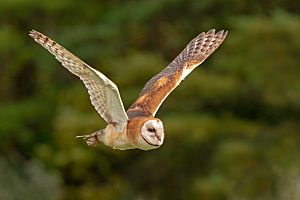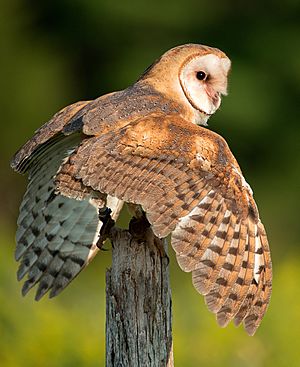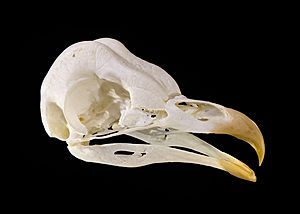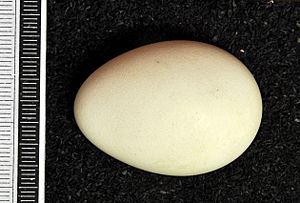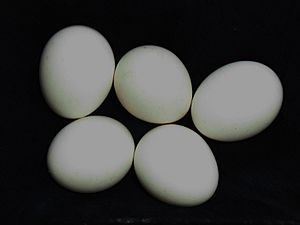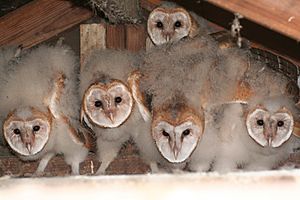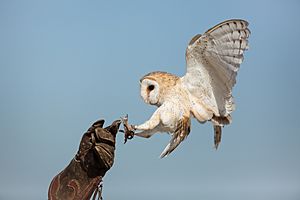Barn owl facts for kids
Quick facts for kids Barn owl |
|
|---|---|
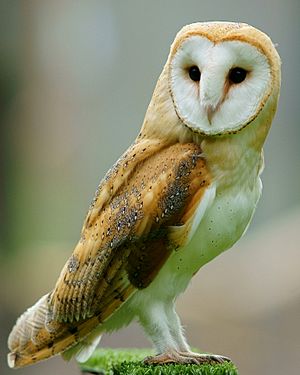 |
|
| A barn owl at the British Wildlife Centre, England | |
| Conservation status | |
| Scientific classification | |
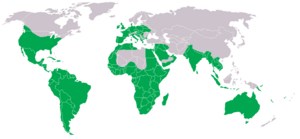 |
|
| Global range in green | |
| Synonyms | |
|
The barn owl (Tyto alba) is the most widespread type of owl in the world. You can find it almost everywhere! It lives on every continent except Antarctica. It also avoids very cold polar areas, hot deserts, and some islands. People often call it the common barn owl to tell it apart from other owls in its family, the Tytonidae.
There are at least three main groups of barn owls. These include the western barn owl found in Europe, western Asia, and Africa. There's also the eastern barn owl from southeastern Asia and Australia, and the American barn owl in the Americas. Barn owls come in different sizes and colors, with about 28 known types (subspecies). Most are about 33 to 39 cm (13 to 15 in) long. Their wings can spread from 80 to 95 cm (31 to 37 in).
Barn owls have mottled grey or brown feathers on their heads and backs. Their undersides can be white to brown, sometimes with dark spots. Their face is shaped like a heart and is usually white. Unlike other owls, barn owls don't hoot. Instead, they make a long, eerie screech.
Most barn owls hunt at night. But in places like Great Britain, they sometimes hunt during the day. They are experts at catching small mammals on the ground. They use their amazing hearing to find prey in the dark. Barn owls usually stay with one partner for life. If one owl dies, the other might find a new mate. They lay eggs at different times of the year, depending on where they live. A typical nest has about four eggs. The female owl sits on the eggs, and the male brings food for her and the young chicks. When there's plenty of food, barn owl numbers can grow quickly. Globally, they are not considered endangered.
Contents
What is a Barn Owl?
Naming the Barn Owl
The barn owl was first described in 1769 by a doctor and naturalist named Giovanni Antonio Scopoli. He gave it the scientific name Strix alba. Later, scientists decided that the Strix name should only be for "wood owls." So, the barn owl got its new name, Tyto alba.
The name Tyto alba means 'white night owl'. Tyto comes from an old Greek word for 'night owl'. Alba is a Latin word meaning 'white'.
This bird has many common names that describe how it looks, sounds, or where it lives. Some names include white owl, ghost owl, death owl, night owl, and screech owl. "Screech owl" is a good name because of their piercing calls. However, there's another group of birds also called screech-owls, which are different.
What Do Barn Owls Look Like?
The barn owl is a medium-sized owl. It has pale feathers, long wings, and a short, square-shaped tail. Its size can vary a lot depending on where it lives. For example, male owls from the Galapagos Islands weigh about 260 grams (9.2 oz). Male Pacific barn owls can weigh around 555 grams (19.6 oz). Owls on small islands are often smaller. This might be because they eat more insects and need to be more agile.
You can tell a barn owl from other owls by its flight. It has an wavy flight pattern and feathered legs that dangle. Its pale, heart-shaped face and black eyes make it look unique when flying.
The feathers on the owl's head and upper body are usually pale brown or grey. Some are a richer brown. They all have tiny black and white speckles. The heart-shaped face is usually bright white. The feathers on their undersides can be white to reddish-brown. They might have small dark spots. Female barn owls with more spots are often healthier. Their eyes are dark brown, and their talons (claws) are black.
Male barn owls usually have fewer spots and are paler than females. Females are also larger. A strong female can weigh over 550 grams (1.2 lb). Baby owls are covered in white fluffy down. Their heart-shaped face appears soon after they hatch.
Barn owls do not hoot. That sound is made by other owls, like the tawny owl. Barn owls make a loud, piercing scream. It can be very loud up close! Males make a high-pitched twitter during courtship. Both young and old owls can hiss like a snake to scare away intruders. They also make a purring sound when they are happy. If caught, a barn owl will lie on its back and kick with its sharp talons. It might also make rasping sounds or clicking noises with its beak.
Where Do Barn Owls Live?
The barn owl is the most widespread land bird in the world. It lives on every continent except Antarctica. Its range covers most of Europe, much of Africa, India, Southeast Asia, Australia, and North, Central, and South America.
Barn owls usually stay in one place. Many owls live in the same area even if there are better places nearby. In the British Isles, young owls often move along rivers. They travel about 9 km (5.6 mi) from where they were born. In Europe, they travel further, usually 50 to 100 km (31 to 62 mi). Some have even flown 1500 km (930 mi)! In the United States, they typically travel 80 to 320 km (50 to 200 mi). Some have gone as far as 1760 km (1,090 mi).
In Australia, barn owls sometimes migrate. They move north in the dry season and south in the wet season. They also move around when there are lots of rodents. Sometimes, they even fly to islands like New Zealand, showing they can cross oceans. Barn owls were brought to the Hawaiian island of Kauai to help control rodents. Sadly, they also started eating native birds there.
Barn owls like open areas like farmland or grassland with some trees. They usually live below 2000 meters (6,600 ft) in height. They prefer to hunt along the edges of woods or in grassy areas next to pastures. They fly silently, gliding and hovering over the ground. Tiny ridges on their wing feathers and a soft fringe help them fly without making noise. This quiet flight helps them sneak up on prey.
How Do Barn Owls Hunt and Eat?
Barn owls hunt during twilight or at night. They can spot their prey and dive to the ground. Their legs and toes are long and thin. This helps them find food in thick plants or under snow. It also gives them a wide grip when they catch prey. They fly slowly, searching the ground, and can hover. They have long, wide wings that help them turn quickly.
Barn owls have amazing hearing. Their ears are placed unevenly on their head. This helps them figure out exactly where a sound is coming from and how far away it is. They don't even need to see their prey to catch it! Their heart-shaped face also helps with hearing. It directs sounds to their ears. They might also sit on branches or fence posts to look for prey.
Small mammals like rodents make up over 90% of their diet. They also eat birds, lizards, amphibians, fish, and insects. In North America and Europe, voles are their main food. Shrews are the second most common. In Ireland, when bank voles were accidentally introduced, barn owls started eating them a lot. In warmer areas like the Mediterranean and Australia, mice and rats are their main food. They also eat gophers, muskrats, hares, rabbits, and bats. Barn owls are usually picky eaters where food is plentiful. But where food is scarce, they will eat many different things.
On the Cape Verde Islands, geckos are their main food. They also eat birds like plovers and weavers. On a rocky island off California, barn owls were seen raising their young on a diet of storm petrels. On islands with many birds, birds can make up 15-20% of their diet. In grasslands, they might eat swarming termites or large crickets. Smaller prey is usually eaten whole, including bones and fur. But they often leave the inedible parts of larger prey, like baby rabbits.
Barn owls need more food than other owls of similar size. They have a faster metabolism. A barn owl might eat one or more voles each night. This is about 14% of its body weight! They often hide extra food at their roosting spots. This food can be used when food is hard to find. This makes barn owls very helpful to farmers. Farmers often find that barn owls are better than poison at controlling rodent pests. They can encourage barn owls by providing places for them to nest.
How Do Barn Owls Breed?
Barn owls in warm, tropical areas can breed any time of year. But they often lay eggs during the dry season. This is when more rodent prey is available. In dry regions like parts of Australia, breeding might happen only during wet periods when small mammal populations increase. In areas with changing seasons, nesting times are more specific.
In Europe and North America, most nesting happens between March and June. This is when temperatures rise. The exact dates depend on the year and location. They are linked to how much food is available near the nest. If there are many rodents, barn owls will start nesting. They often raise two groups of chicks in a good year.
Female owls can start breeding when they are about ten to eleven months old. Barn owls usually mate for life. They stay with one partner unless one dies. Outside the breeding season, they might sleep in different places. But when breeding season starts, they return to their usual nesting spot.
Once a pair forms, the male owl will fly around the nesting area at dusk. He will then fly further to find a hunting area. When the female joins him, they chase each other in the air. They make many screeches. The male's screech is high-pitched, and the female's is lower. Later, the male flies high into the sky and then swoops down fast near the female. Then he goes to hunt. The female waits and cleans her feathers. She returns to the nest just before the male brings her food. This feeding helps the pair bond and makes the female strong for laying eggs.
Barn owls nest in holes. They choose holes in trees, cracks in cliffs, or large nests of other birds. In Europe and North America, they often use old buildings like farm sheds and church towers. Buildings are better than trees in wet climates. They offer more protection for the young owls from bad weather. Tree nests are usually in open areas, not deep in forests. Barn owls don't use nesting materials. But as the female sits on the eggs, she pulls in soft, dry fur from her regurgitated pellets. So, by the time the chicks hatch, they are surrounded by a soft carpet of shredded pellets. Other birds, like jackdaws, sometimes nest in the same tree or building and seem to get along with the owls.
Before laying eggs, the female stays near the nest. The male brings her all her food. The male also sleeps nearby and might hide any extra food. When the female is at her heaviest, the male brings her food as a special gift. The female lays eggs every other day. A typical nest has about five eggs, but it can be from two to nine. The eggs are white and about the size of small chicken eggs. The female starts sitting on the eggs as soon as the first one is laid. The male keeps bringing her food, which might pile up next to her.
The eggs hatch after about 30 days. The chicks hatch over a few weeks, so the youngest chick might be much smaller than its older brothers and sisters. In years with lots of food, about 75% of the eggs hatch successfully.
The chicks are born with greyish-white down feathers. They grow quickly. Within a week, they can lift their heads and move around the nest. The female tears up the food the male brings and gives it to the chicks. At first, the chicks make a "chittering" sound. This soon changes to a "snoring" sound when they want food. By two weeks old, they are half their adult weight. By three weeks, their adult feathers start to grow. They stand up, make snoring noises, and beg for food, which is now given whole. Baby barn owls can even "negotiate" and let weaker siblings eat first, perhaps in exchange for grooming.
The male brings most of the food until all the chicks are at least four weeks old. Then the female starts to leave the nest and sleep elsewhere. By six weeks, the chicks are as big as adults. By nine weeks, they are fully feathered and start leaving the nest for short times. They still depend on their parents until about thirteen weeks old. The female teaches them how to find and catch prey.
Barn Owl Feathers and Molting
Birds need to replace their feathers as they wear out. This process is called molting. Barn owls rely on quiet flight. So, their feathers are very important. In areas with changing seasons, owls molt over two years in three stages. The female starts molting while she is sitting on eggs and caring for chicks. During this time, the male feeds her, so she doesn't need to fly much.
The male owl molts later in the year than the female. This is when there is plenty of food, and the female has started hunting again. The chicks also need less food. Unmated males without young often start molting earlier. Their molting pattern is similar to the female's. One sign that a male is molting is finding a tail feather at his roosting spot. Molting means losing some warmth. This is not a problem in warm places. Barn owls in tropical areas usually replace all their flight feathers every year.
Who Hunts Barn Owls?
Larger animals sometimes hunt barn owls. These include large opossums, raccoons, eagles, bigger hawks, and other owls. For example, the great horned owl in the Americas and the Eurasian eagle-owl in Europe are known to hunt barn owls. One study found that barn owls made up about 10% of the great horned owl's diet in Washington state. In Africa, large eagle-owls also hunt barn owls. In Europe, the northern goshawk and common buzzard are main daytime hunters. About 12 other large birds of prey also hunt barn owls.
When a barn owl is disturbed at its resting spot, it might get angry. It will lower its head and sway it from side to side. Or it might stretch its head forward, spread its wings, and make hissing and beak-snapping noises. Another way they defend themselves is by lying flat on the ground or crouching with their wings spread out.
Barn owls can have many parasites. Fleas live in their nests. Feather lice and mites live on their feathers. Blood-sucking flies also live among their feathers. They can also have internal parasites like flukes, tapeworms, and roundworms in their gut. These parasites are caught when the owls eat infected prey. Studies suggest that female owls with more spots might be better at fighting off external parasites.
Barn owls usually live for about four years. In Scotland, some have lived up to 18, and possibly even 34 years! A big reason for deaths in cooler areas is starvation, especially in winter when there's a lot of snow.
Another cause of death is hitting cars on roads. This happens when owls hunt on grassy areas next to roads. Some of these owls might be weak and less able to avoid cars. In some places, many owls die from road collisions. This can happen more where there is heavy traffic, grassy roadsides, and lots of small mammals. In the past, many owls died from pesticides. This might still happen in some parts of the world. Hitting power lines and being shot also kill some owls, especially in Mediterranean areas.
Barn Owl Conservation

Barn owls are quite common in most places they live. They are not considered globally endangered. If we count all barn owls as one species, they are the second most widespread bird of prey. Only the peregrine falcon is found in more places. The barn owl is also likely the most numerous bird of prey. The International Union for Conservation of Nature (IUCN) estimates there might be nearly 10 million barn owls worldwide.
However, their numbers have dropped in some areas. This was due to harmful chemicals like DDT in the mid-1900s and rodent poisons later on. Modern farming often removes the rough grasslands that barn owls use for hunting. While barn owls can have many babies and recover from short-term drops in numbers, they are not as common in some places as they used to be. In the US, barn owls are listed as endangered in seven Midwestern states. In Europe, they are a "Species of European Concern."
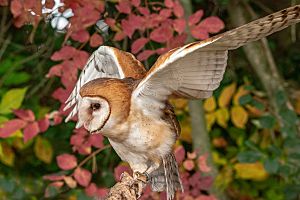
In Canada, barn owls are rare. They are mostly found in coastal British Columbia. They have become very rare in southern Ontario. Even with efforts to help them, only a few wild barn owls lived in Ontario in 2018. This is mainly because their hunting grounds (grasslands) are disappearing. Other reasons include harsh winters, predators, road deaths, and rodent poisons. The species is listed as endangered in Canada because of habitat loss and a lack of nesting spots.
On the Canary Islands, the Canary barn owl is very rare. There might be fewer than two hundred left. Their numbers have dropped a lot on the western Canary Islands. People also sometimes kill them on purpose.
Conservationists often use nest boxes to help barn owl populations. When natural nesting spots are scarce, these boxes provide homes. Barn owls often accept these boxes and sometimes prefer them. The boxes are placed under building roofs or in other suitable spots. More nest boxes mean more barn owls, as long as there is enough food. Farmers and landowners are encouraged to install nest boxes. This is because more barn owls mean natural rodent control, which can be cheaper than using poisons.
Barn Owls in Culture
Some common names for barn owls, like "demon owl" or "ghost owl," show that people in many places used to think they were bad luck. For example, the Tzeltal people in Mexico thought they brought diseases. Barn owls don't hoot; they screech and hiss. Their white face and belly feathers, visible when they fly, make them look "ghostly." Because of this, farmers often killed them, not knowing how helpful they were. People also wrongly believed they ate large animals like chickens or cats. In Thailand, people believe that if a barn owl flies over or lands on a house, someone in that house will die. In South Africa, barn owls are sometimes linked to witchcraft and are harmed. Some South African cultures use parts of owls in traditional medicine, believing it gives special powers.
In India, beliefs about the barn owl are different. Hindus believe the owl is the animal companion and symbol of Lakshmi, the goddess of wealth and good fortune.
See also
 In Spanish: Lechuza común para niños
In Spanish: Lechuza común para niños



